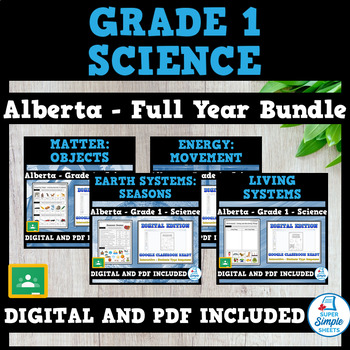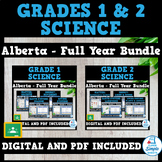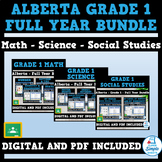Alberta Grade 1 Science - Full Year Bundle - NEW 2023 CURRICULUM
- Zip
- Google Apps™

What educators are saying
Products in this Bundle (4)
Also included in
- Grades 1 and 2 – Alberta Science Curriculum – This resource covers all outcomes in the NEW 2023 Alberta Science Curriculum. GOOGLE CLASSROOM VERSION - PDF INCLUDED! This gives you the ability to print worksheets as well as distribute a digital copy of the resource to your students on Google ClassroPrice $40.00Original Price $56.00Save $16.00
- NEWLY UPDATED FOR THE 2022 AND 2023 CURRICULUMS! BOTH PDF AND GOOGLE SLIDES VERSIONS INCLUDED!FULL YEAR BUNDLE - Teaching made easy! This NO PREP - PDF/GOOGLE SLIDES VERSION bundle includes everything you need to teach Math, Science and Social Studies. It covers all the expectations in the Alberta cPrice $70.00Original Price $88.00Save $18.00
Description
Grade 1 – Alberta Science Curriculum – This resource covers all outcomes in the NEW 2023 Alberta Science Curriculum.
GOOGLE CLASSROOM VERSION - PDF INCLUDED! This gives you the ability to print worksheets as well as distribute a digital copy of the resource to your students on Google Classroom.
Check out each of the strands below to learn more about the resources included in this bundle.
Matter: Objects
Some of the concepts that are covered:
- What are objects?
- Different lengths of objects – width, height, and depth
- Activity – comparing the height of different objects
- Scavenger hunt – finding shorter and taller objects than your pencil
- Activity – comparing the width of objects and ordering objects based on their width
- Comparing depths of objects – televisions, vehicles, boxes
- Area of objects
- Scavenger hunt – finding objects with less area and more area than your hand
- Activity – measuring the area of objects using footprints
- Superimposing objects to compare their area
- Activity - Which object has more mass?
- Comparing mass – heavy versus light objects
- Ordering the weight of objects
- Scavenger hunt – finding objects lighter and heavier than your shoe
- Measuring weight/mass experiment – comparing the weight of two objects
- Changing objects – physical changes that only change the look of the object/material
- Bending objects – can the object be bent?
- Activity – bending/folding paper to make a paper airplane
- Twisting objects – can the object be twisted?
- Activity – Making a Twisted Sculpture
- Cutting objects – can the object be cut?
- Activity – how does cutting an object change the object?
- Activity – what tool is best for cutting?
- Stretching objects – what happens to the object?
- Can the object be stretched?
- Experiment – Stretch it out!
- Breaking objects – is the object easily broken?
- Experiment – changing objects: can the object be changed (cut, bent, stretched, twisted, broken)
- Activity – working with clay to make something useful
- Changing objects to make a new texture
- Experiment – creating different textures using sandpaper
- Experiment – different textures of food after changing food objects
- Computer science – making objects by following the coding instructions
- Assignment – making a pencil holder
- Unit Test
- Answer pages for all activities
Energy (Movement)
Some of the concepts that are covered:
- What is movement?
- Describing the position of objects: above, below, next to, beside, near, between
- Describing the movement of objects: up, down, forward, backward, sideways, toward and away
- Writing directions and following directions: up, down, right, left
- Movement pathways – straight, curved, spiral, circular, zig-zag, up and down, back and forth
- Story – Sammy the Squirrel: drawing his movements
- Coding activity – writing coding commands for a movement obstacle course
- Coding activity – robot lawn mower
- Animals and objects that roll
- Activity – will the object roll?
- Experiment – testing whether objects will roll down a slide
- Invention of the wheel
- Activity – making a wheel
- Objects that bounce
- Experiment – testing how bouncy objects are
- Bouncy material: rubber
- Animals and objects that slide
- Experiment – testing if objects will slide on different surfaces
- Smooth versus rough surfaces
- Experiment – friction car ramp
- Activity – will the object roll or slide?
- What is speed?
- Comparing the speed of animals
- Ordering the speeds of vehicles
- Describing changes in speed
- Activity – Speed Detectives
- Game – Red Light, Green Light
- Experiment – Racing Cars
- Unit Test
- Answer pages for all activities
Earth Systems (Seasons)
Some of the concepts that are covered:
- The Sun – source of light and heat
- Life without the Sun
- How the Sun causes seasons
- Experiment – orbiting Earth around the Sun
- 3 seasons in India and Thailand – cold, rainy, dry
- 2 seasons in Africa (dry and rainy seasons)
- Experiment – creating models of rainy and dry seasons
- Seasons – different amounts of heat and light
- Activities we do in each season – summer, fall, winter, spring
- How animals have adapted to seasonal changes
- Plants adapting to changing seasons – falling leaves
- Thicker fur, dormancy of plants, migration and hibernation
- Clothing we wear in each season
- How humans adapt to seasonal change – air conditioners, clothing, furnace
- Non-seasonal activities – indoor arenas, swimming indoors, hockey in the summer
- Activity – making dog booties
- Summer storms – hailstorms, thunderstorms, and tornados
- Summer season - wildfires
- Winter storms – blizzard and ice storm
- Coding activities – following instructions to play dress up
- Coding activities – making a paper snowflake
- Coding activity – drawing a flower
- Seasonal cycles in your life – sports and activities you do at different times of the year
- Taking care of the environment – keeping water clean
- Food from our environment
- How the Indigenous take care of the environment
- Cree First Nation Seasonal Round
- Dene First Nation Seasonal Round
- Metis Seasonal Round
- Unit Test
- Answer pages for all activities
Living Systems - Needs of Living Things
Some of the concepts that are covered:
- Living things versus non-living things
- Living things – plants and animals
- Animals move while plants stay still
- Body parts of humans and other animals
- Describing common characteristics of animals
- Nocturnal versus diurnal animals
- Variations of human characteristics – eye, hair, and skin colour
- Different types of plants – grasses, trees, creepers, climbers, shrubs
- Life processes – breathing, sleeping, growing, eating
- Basic needs of animals
- Basic needs of plants
- Experiment – growing a plant in different environments
- How to care for a pet
- Research – favourite animal
- How humans meet their basic needs – using tools
- How animals meet their basic needs – locomotion
- How living things use the environment to meet their needs
- Plants and animals in forests
- Plants and animals living on the prairies
- Plants and animals living in lakes and rivers
- Plants and animals living on mountains
- What animals eat from the environment
- How animals eat – swallowing whole, tearing, cracking, chewing their food
- Shelters – how animals use their environment to make shelters
- Harmful plants and animals (poison ivy, wild animals)
- Having allergies to plants and animals – shared reading story
- Keeping the environment clean
- Air and water pollution
- Creating a zoo environment for an animal – understanding their basic needs
- Hobbies and jobs working with animals
- Showing respect for living things – how to keep the environment healthy
- Understanding misinformation in movies – animals can’t speak English
- Coding activities – robot zoo worker
- Coding activities – coding an animal maze
- Unit Test
- Answer pages for all activities
This is a comprehensive bundle that will save you hours of planning! It has been tested and found effective in helping students achieve the learning outcomes in the science curriculum.
Answer pages for all slides/sheets are included!
Follow Super Simple Sheets for more resources like this one!




